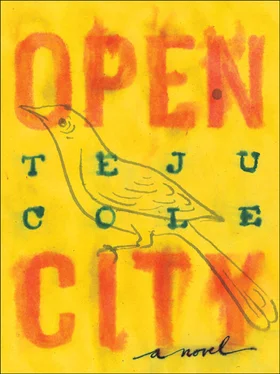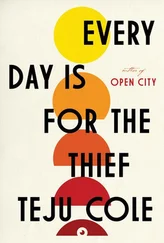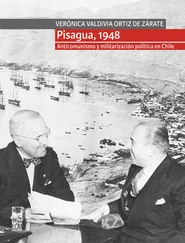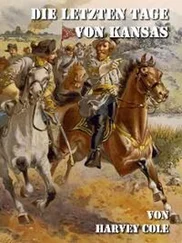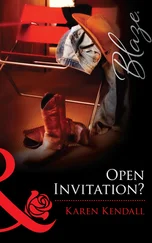Away from the water, in the plaza behind the World Financial Center, was a small semienclosed space consisting of a fountain, plant beds with rushes, and two marble walls, one higher than the other. The walls were inscribed, and on the lower wall was a plaque: DEDICATED TO THE MEMORY OF THOSE MEMBERS OF THE POLICE DEPARTMENT WHO LOST THEIR LIVES IN SERVICE TO THE PEOPLE OF THE CITY OF NEW YORK. On the other wall, there was a list, with dozens of names on it. At the very top was the first entry — PTL. JAMES CAHILL, SEPTEMBER 29, 1854. It went on like that through the years, one entry after the other, rank, name, date of death; there was the expected, disheartening cluster in the fall of 2001, then a few others who died in the years that followed. Below that was a vast, blank face of polished marble, awaiting those among the living who would die in uniform, and the not yet born, who would be born, grow up to be police officers, and be killed while doing that work.
Across the plaza, on the other side of the West Side Highway, the big buildings of the trading district were lined up on an invisible perimeter like animals jostling for space on the edge of a lake, taking care not to pitch forward. The perimeter marked out the massive construction site. I walked up to a second overpass, the one that once connected the World Financial Center to the buildings that stood on the site. Until that moment, I had been a lone walker, but people then began to troop out of the World Financial Center, men and women in dark suits including a group of young Japanese professionals who, tailed by the rapid stream of their conversation, hurried by me. Above them, for the third time that evening, I saw the bright lights of an exercise facility with the rows of bicycles, in this case looking out onto the construction site. What, I wondered, went through the minds of the exercisers as they pedaled and strained and looked out there? When I came up to the overpass, I was able to share their view: a long ramp that extended into the site, and the three or four tractors scattered around inside it that, dwarfed by the size of the pit, looked like toys. Just below street level, I saw the sudden metallic green of a subway train hurtling by, exposed to the elements where it crossed the work site, a livid vein drawn across the neck of 9/11. Beyond the site was the building I had seen earlier in the evening, the one wrapped in black netting, mysterious and severe as an obelisk.
The overpass was full of people. In its rafters were brightly colored advertisements for various tourist sites in lower Manhattan. SHOW YOUR KIDS WHERE THE ALIENS LANDED, the one for Ellis Island read. The Museum of American Finance was promoted with the words RELIVE THE DAY AMERICA’S TICKER STOPPED. The Police Museum, also entering the spirit of distasteful puns, invited people to visit New York’s first cell provider. The commuters with me marched along, shoulders up, heads low, all in black and gray. I felt conspicuous, the only person among the crowd who stopped to look out from the overpass at the site. Everyone else went straight ahead, and nothing separated them, nothing separated us, from the people who had worked directly across the street on the day of disaster. When we descended the stairs into Vesey Street, we were hemmed in on both sides by a chain-link fence, penned in, “like animals” stumbling to the slaughter. But why was it permitted to treat even animals that way? Elizabeth Costello’s nagging questions showed up in the strangest places.
But atrocity is nothing new, not to humans, not to animals. The difference is that in our time it is uniquely well-organized, carried out with pens, train carriages, ledgers, barbed wire, work camps, gas. And this late contribution, the absence of bodies. No bodies were visible, except the falling ones, on the day America’s ticker stopped. Marketable stories of all kinds had thickened around the injured coast of our city, but the depiction of the dead bodies was forbidden. It would have been upsetting to have it otherwise. I moved on with the commuters through the pen.
This was not the first erasure on the site. Before the towers had gone up, there had been a bustling network of little streets traversing this part of town. Robinson Street, Laurens Street, College Place: all of them had been obliterated in the 1960s to make way for the World Trade Center buildings, and all were forgotten now. Gone, too, was the old Washington Market, the active piers, the fishwives, the Christian Syrian enclave that was established here in the late 1800s. The Syrians, the Lebanese, and other people from the Levant had been pushed across the river to Brooklyn, where they’d set down roots on Atlantic Avenue and in Brooklyn Heights. And, before that? What Lenape paths lay buried beneath the rubble? The site was a palimpsest, as was all the city, written, erased, rewritten. There had been communities here before Columbus ever set sail, before Verrazano anchored his ships in the narrows, or the black Portuguese slave trader Esteban Gómez sailed up the Hudson; human beings had lived here, built homes, and quarreled with their neighbors long before the Dutch ever saw a business opportunity in the rich furs and timber of the island and its calm bay. Generations rushed through the eye of the needle, and I, one of the still legible crowd, entered the subway. I wanted to find the line that connected me to my own part in these stories. Somewhere close to the water, holding tight to what he knew of life, the boy had, with a sharp clack, again gone aloft.
It was back in summer, on the day we went on a trip out to Queens with an organization from Nadège’s church called the Welcomers, that I saw, for the first time, the link between her and another girl I’d once known. That other girl had been hidden in my memory for more than twenty-five years; to suddenly remember her, and instantly tie her to Nadège, was a shock. I must have been circling subconsciously around the idea for several days, but seeing the link solved a problem. I never spoke to Nadège of the other girl, whose name I had forgotten, whose face had blurred in memory, of whom I now retained only the image of a limp. It wasn’t a deception: all lovers live on partial knowledge.
The girl’s problem was far worse than Nadège’s. She had polio, which had withered her left foot into a twisted stump she dragged behind her when she walked. The articulated steel brace she used for support was always on her left arm. Watching her walk across the field at my primary school, I was afraid that the boys would mock her; that was my first instinct, a gallant, protective one. She was in my class, but I remember little now of what we talked about the three or four times we spoke to each other. I liked her ability to be comfortable with herself, and the way that, once she sat down, she was no different from other children, and in fact had a brightness about her that was out of the ordinary. She might have been the best student in class had she stayed, but her parents withdrew her, and she went to another school. I never saw her again after those first two weeks. And only when Nadège came down from the bus in Queens, on that Welcomers excursion, did I see the similarity, the echo that was like John the Baptist’s echo of Elijah, two individuals separated in time and vibrating on a singular frequency, only then did I remember that I had imagined a future life with this other girl when we had both been eight or nine years old, the first time I had ever had such a thought, and of course with no idea of what it might entail.
I had seen myself as a grown man, protecting her as one might protect a pet, having many children with her, but I did not think of having her as a girlfriend. I don’t think I even had such a concept then. I didn’t pity Nadège as I had the other girl. The limp was only a visual cue, hardly noticeable in Nadège’s case, and no great impediment to her; perhaps it offended her vanity a little but that was all. Sometimes, she said, when she wore adjusted shoes, it wasn’t even noticeable. It was a hip problem, which she’d had surgery to correct in her late teens, by which time it was too late. It should have been done much earlier, but at least the procedure released her from chronic pain.
Читать дальше
